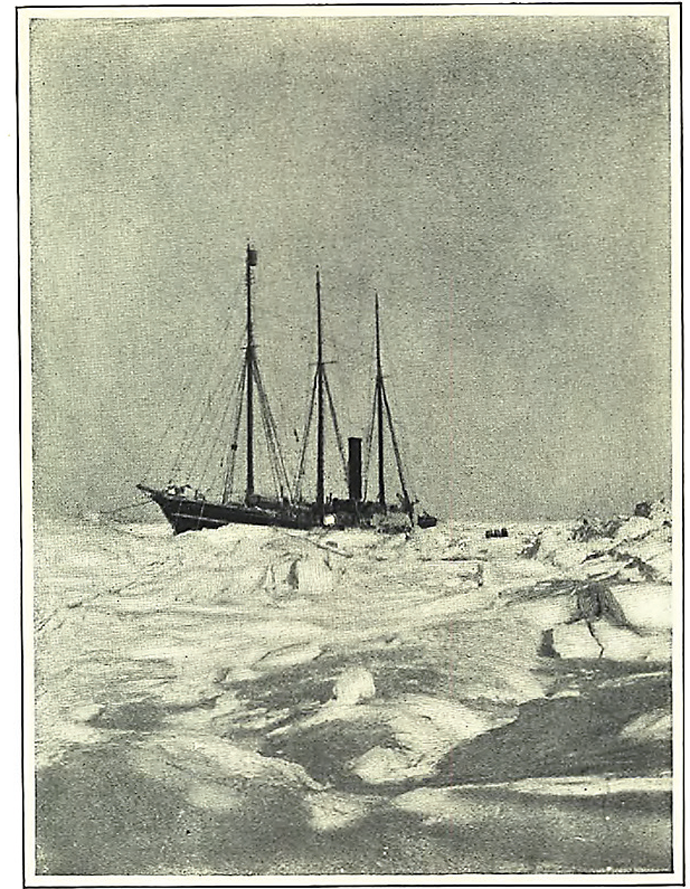On the sixteenth of July, 1905, the steamer Roosevelt left New York Harbor for her northern voyage. Her course from the anchorage was noisy with the friendly greetings of every shore and passing whistle; but at the Roosevelt’s masthead only a single flag, the Stars and Stripes, fluttered in the wind, embodying not only the American idea, but my own deep sense of responsibility.
In the earliest hours of August 17, the Roosevelt swung out from the harbor of Etah and severed all communication with the civilized world. Belowdecks the ship was filled with coal; on deck were over two hundred dogs.

“During the Arctic Night,” an engraving of an original photograph of the Roosevelt made under the December full moon, 1905
From Joe Island to Cape Lupton we steamed through completely ice-free water, in the teeth of a stiff northerly gale, across a swell that caused the Roosevelt to pitch perceptibly. West along the coast, the ice lay densely packed and without a break.
On the evening of September 16, with the turn of the flood tide, a large floe pivoted around Cape Sheridan, crushing everything before it, until at last it held the ship mercilessly between its own blue side and the unyielding face of the ice foot. For an instant, which seemed an age, the pressure was terrific. The big floe snapped, then came to rest, and the commotion was transferred to the outer edge of the floe, which crumbled away with a dull roar—leaving us stranded but safe. This incident, of course, put an end to thoughts of farther advance, and, to provide against the contingency of a still more serious pressure rendering the ship untenable, all supplies and equipment were landed, officers and crew working almost without interruption for the next thirty-six hours.
On Christmas night the ice suddenly broke completely away from the shore and disappeared in the inky darkness, leaving the starboard side of the Roosevelt exposed and unprotected. Simultaneously a violent southerly gale began which threatened to tear the ship from her moorings.
The next three weeks was a period of constant anxiety, the ice pack surging back and forth along the shore on each tide, and liable to crash in upon us at any time. Everyone slept in his clothes, all lanterns and portable lights were kept filled and trimmed, ready for immediate use, and provision was made for the instant extinguishment of all fires.
The first march of ten hours, myself in the lead with the compass, sometimes on a dogtrot, the sledges following in Indian file with drivers running beside or behind, placed us thirty miles to the good. I had with me now seven men and six teams with less than half a load for each.
As we advanced, the character of the ice improved, the floes becoming much larger and pressure ridges infrequent, but the cracks and narrow leads increased, and were nearly all active. These cracks were uniformly at right angles to our course, and the ice on the northern side was moving more rapidly eastward than that on the southern.
As dogs gave out, unable to keep the pace, they were fed to the others. On April 20 we came into a region of open leads, trending nearly north and south, and the ice motion became more pronounced. Hurrying on between these leads, a march was made. Then we slept a few hours, and starting again soon after midnight, pushed on till noon of the twenty-first.
My observation then gave 87°6’ N. So far as history records, this is the nearest approach to the North Pole ever made by human beings.
I thanked God with as good a grace as possible for what I had been able to accomplish. My flags were flung out from the summit of the highest pinnacle near us, and a hundred feet or so beyond this I left a bottle containing a brief record.
Then we started to return to our last igloo, making no camp here.
From “Nearest the North Pole,” which appeared in the February 1907 issue of Harper’s Magazine.












































































































































































